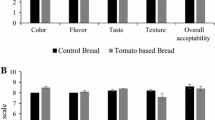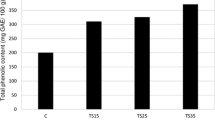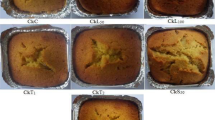Abstract
The tomato processing industry generates high amounts of waste, mainly tomato skins and seeds, which create environmental problems. These residues are attractive sources of valuable bioactive components and pigments. A relatively simple recovery technology could consist of production of powders to be directly incorporated into foods. Tomato waste coming from a Romanian tomato processing unit were analyzed for the content of several bioactive compounds like ascorbic acid, β-carotene, lycopene, total phenolics, mineral and trace elements. In addition, its antioxidant capacity was assayed. Results revealed that tomato waste (skins and seeds) could be successfully utilized as functional ingredient for the formulation of antioxidant rich functional foods. Dry tomato processing waste were used to supplement wheat flour at 6 and 10 % levels (w/w flour basis) and the effects on the bread’s physicochemical, baking and sensorial characteristics were studied. The following changes were observed: increase in moisture content, titratable acidity and bread crumb elasticity, reduction in specific volume and bread crumb porosity. The addition of dry tomato waste at 6 % resulted in bread with good sensory characteristics and overall acceptability but as the amount of dry tomato waste increased to 10 %, bread was less acceptable.

Similar content being viewed by others
References
Adalid AM, Roselló S, Nuez F (2010) Evaluation and selection of tomato accessions (Solanum section Lycopersicon) for content of lycopene, β-carotene and ascorbic acid. J Food Compos Anal 23:613–618
Altan A, McCarthy KL, Maskan M (2008) Evaluation of snack foods from barley-tomato pomace blends by extrusion processing. J Food Eng 84:231–242
Alves AB, Bragagnolo N, da Silva MG, Skibsted LH, Orlien V (2012) Antioxidant protection of high-pressure processed minced chicken meat by industrial tomato products. Food Bioprod Process 90:499–505
American Association of Cereal Chemists (2003) Approved methods of the AACC. St. Paul, MN
Baysal T, Ersus S, Starmans DAJ (2000) Supercritical CO2 extraction of β-carotene and lycopene from tomato paste waste. J Agric Food Chem 48:5507–5511
Benakmoum A, Abbeddou S, Ammouche A, Kefalas P, Gerasopoulos D (2008) Valorisation of low quality edible oil with tomato peel waste. Food Chem 110:684–690
Borguini RG, Da Silva Torres EAF (2009) Tomatoes and tomato products as dietary sources of antioxidants. Food Rev Int 25:313–325
Calvo MM, García ML, Selgas MD (2008) Dry fermented sausages enriched with lycopene from tomato peel. Meat Sci 80:167–172
Capanoglu E, Beekwilder J, Boyacioglu D, De Vos RCH, Hall RD (2010) The effect of industrial food processing on potentially health-beneficial tomato antioxidants. Crit Rev Food Sci 50:919–930
Celma AR, Cuadros F, López-Rodríguez F (2012) Characterization of pellets from industrial tomato residues. Food Bioprod Process 90:700–706
Chérif JK, Jémai S, Rahal NB, Jrad A, Trabelsi-Ayadi M (2010) Study of antioxidant content and antiradical capacity of fresh and industrial waste of Tunisian tomato. Valorization of Tunisian tomato in bioactive molecules. Tunis J Med Plants Nat Prod 4:116–125
Choudhari SM, Ananthanarayan L (2007) Enzyme aided extraction of lycopene from tomato tissues. Food Chem 102:77–81
Cosmulescu S, Baciu A, Achim G, Botu M, Trandafir I (2009) Mineral composition of fruits in different walnut (Juglans regia L.) cultivars. Not Bot Horti Agrobo 37(2):156–160
Demirbas A (2010) Oil, micronutrient and heavy metal contents of tomatoes. Food Chem 118:504–507
Eller FJ, Moser JK, Kenar JA, Taylor SL (2010) Extraction and analysis of tomato seed oil. J Am Oil Chem Soc 87:755–762
García ML, Calvo MM, Selgas MD (2009) Beef hamburgers enriched with lycopene using dry tomato peel as ingredient. Meat Sci 83:45–49
George B, Kaur C, Khurdiya DS, Kapoor HC (2004) Antioxidants in tomato (Lycopersium esculentum) as a function of genotype. Food Chem 84:45–51
Helyes L, Lugasi A, Pogonyi Á, Pék Z (2009) Effect of variety and grafting on lycopene content of tomato (Lycopersicon Lycopersicum L. Karsten) fruit. Acta Aliment Hung 38:27–34
ICC (2004) Determination of the Moisture Content of Cereals and Cereal Products 449 (Practical method). International Association for Cereal Science and Technology. 450 Standard method 110. Approved 1960, revised 1976
Jun X (2006) Application of high hydrostatic pressure processing of food to extracting lycopene from tomato paste waste. High Press Res 26:33–41
Knoblich M, Anderson B, Latshaw D (2005) Analyses of tomato peel and seed byproducts and their use as a source of carotenoids. J Sci Food Agric 85:1166–1170
Kong KW, Khoo HE, Prasad KN, Ismail A, Tan CP, Rajab NF (2010) Revealing the power of the natural red pigment lycopene. Molecules 15:959–987
Lavecchia R, Zuorro A (2008) Improved lycopene extraction from tomato peels using cell-wall degrading enzymes. Eur Food Res Technol 228:153–158
Lavelli V, Torresani MC (2011) Modelling the stability of lycopene-rich by-products of tomato processing. Food Chem 125:529–535
Liadakis GN, Tzia C, Oreopoulou V, Thomopoulos CD (1995) Protein isolation from tomato seed meal, extraction optimization. J Food Sci 60:477–482
Martínez-Valverde I, Periago MJ, Provan G, Chesson A (2002) Phenolic compounds, lycopene and antioxidant activity in commercial varieties of tomato (Lycopersicum esculentum). J Sci Food Agric 82:323–330
Nagata M, Yamashita I (1992) Simple method for simultaneous determination of chlorophyll and carotenoids in tomato fruit. J Jpn Soc Food Sci Technol 39:925–928
Nobre BP, Palavra AF, Pessoa FLP, Mendes RL (2009) Supercritical CO2 extraction of trans-lycopene from Portuguese tomato industrial waste. Food Chem 116:680–685
Nour V, Trandafir I, Ionica ME (2010) HPLC organic acid analysis in different citrus juices under reverse phase conditions. Not Bot Horti Agrobo 38(1):44–48
Oliveira I, Sousa A, Ferreira ICFR, Bento A, Estevinho L, Pereira JA (2008) Total phenols, antioxidant potential and antimicrobial activity of walnut (Juglans regia L.) green husks. Food Chem Toxicol 46:2326–2331
Papaioannou EH, Karabelas AJ (2012) Lycopene recovery from tomato peel under mild conditions assisted by enzymatic pre-treatment and non-ionic surfactants. Acta Biochim Pol 59:71–74
Persia ME, Parsons CM, Schang M, Azcona J (2003) Nutritional evaluation of dried tomato seeds. Poult Sci 82:141–146
Pinela J, Barros L, Carvalho AM, Ferreira IC (2012) Nutritional composition and antioxidant activity of four tomato (Lycopersicon esculentum L.) farmer’ varieties in Northeastern Portugal homegardens. Food Chem Toxicol 50:829–834
Ray RC, El Sheikha AF, Panda SH, Montet D (2011) Anti-oxidant properties and other functional attributes of tomato: an overview. Int J Food Ferment Technol 1:139–148
Rozzi NL, Singh RK, Vierling RA, Watkins BA (2002) Supercritical fluid extraction of lycopene from tomato processing byproducts. J Agric Food Chem 50:2638–2643
Sabio E, Lozano M, Montero de Espinosa V, Mendes RL, Pereira AP, Palavra AF, Coelho JA (2003) Lycopene and β-carotene extraction from tomato processing waste using supercritical CO2. Ind Eng Chem Res 42:6641–6646
Savatović SM, Gordana S, Ćetković GS, Čanadanović-Brunet JM, Djilas SM (2010) Utilisation of tomato waste as a source of polyphenolic antioxidants. Acta Period Technol 41:187–194
Schieber A, Stintzing FC, Carle R (2001) By-products of plant food processing as a source of functional compounds – recent developments. Trends Food Sci Technol 12:401–413
Shixian Q, Dai Y, Kakuda Y, Shi J, Mittal G, Yeung D, Jiang Y (2005) Synergistic anti-oxidative effects of lycopene with other bioactive compounds. Food Rev Int 21:295–311
Singleton VL, Rossi JA (1965) Colorimetry of total phenolics with phosphomolybdic–phosphotungstic acid reagent. Am J Enol Vitic 16:144–158
Tommonaro G, Poli A, De Rosa S, Nicolaus B (2008) Tomato derived polysaccharides for biotechnological applications: chemical and biological approaches. Molecules 13:1384–1398
Toor RK, Savage GP (2005) Antioxidant activity in different fractions of tomatoes. Food Res Int 38:487–494
Topal U, Sasaki M, Goto M, Hayakawa K (2006) Extraction of lycopene from tomato skin with supercritical carbon dioxide: effect of operating conditions and solubility analysis. J Agric Food Chem 54:5604–5610
Ventura MR, Pieltain MC, Castanon JIR (2009) Evaluation of tomato crop by-products as feed for goats. Anim Feed Sci Technol 154:271–275
Zuorro A, Lavecchia R, Medici F, Piga L (2013) Enzyme-assisted production of tomato seed oil enriched with lycopene from tomato pomace. Food Bioprocess Technol 6(12):3499–3509
Acknowledgments
This work benefited from the networking activities within the european funded COST ACTION FA1106 QualityFruit
Author information
Authors and Affiliations
Corresponding author
Rights and permissions
About this article
Cite this article
Nour, V., Ionica, M.E. & Trandafir, I. Bread enriched in lycopene and other bioactive compounds by addition of dry tomato waste. J Food Sci Technol 52, 8260–8267 (2015). https://doi.org/10.1007/s13197-015-1934-9
Revised:
Accepted:
Published:
Issue Date:
DOI: https://doi.org/10.1007/s13197-015-1934-9




